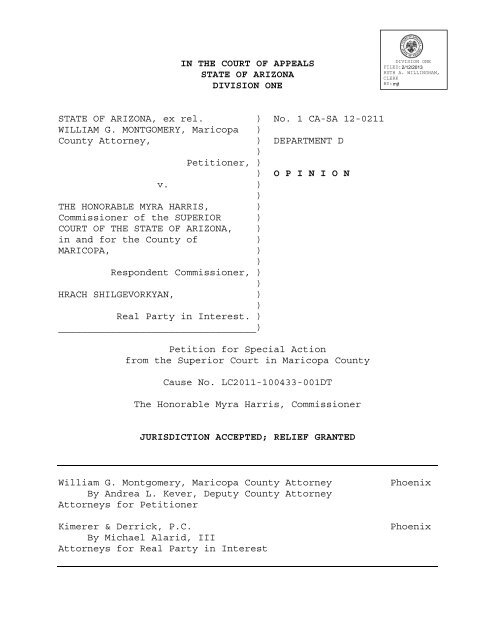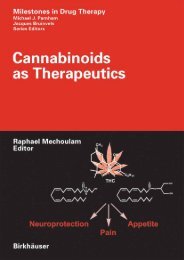Arizona vs Myra Harris PDF - Online Pot
Arizona vs Myra Harris PDF - Online Pot
Arizona vs Myra Harris PDF - Online Pot
Create successful ePaper yourself
Turn your PDF publications into a flip-book with our unique Google optimized e-Paper software.
IN THE COURT OF APPEALSSTATE OF ARIZONADIVISION ONESTATE OF ARIZONA, ex rel. ) No. 1 CA-SA 12-0211WILLIAM G. MONTGOMERY, Maricopa )County Attorney,) DEPARTMENT D)Petitioner, )) O P I N I O Nv. ))THE HONORABLE MYRA HARRIS, )Commissioner of the SUPERIOR )COURT OF THE STATE OF ARIZONA, )in and for the County of )MARICOPA, ))Respondent Commissioner, ))HRACH SHILGEVORKYAN, ))Real Party in Interest. )__________________________________)Petition for Special Actionfrom the Superior Court in Maricopa CountyCause No. LC2011-100433-001DTThe Honorable <strong>Myra</strong> <strong>Harris</strong>, CommissionerJURISDICTION ACCEPTED; RELIEF GRANTEDWilliam G. Montgomery, Maricopa County AttorneyBy Andrea L. Kever, Deputy County AttorneyAttorneys for PetitionerKimerer & Derrick, P.C.By Michael Alarid, IIIAttorneys for Real Party in InterestPhoenixPhoenix
argument about whether the term ‘metabolite’ is singular orplural.” The court recognized it was permitted to interpret thesingular form in the plural to overcome the ambiguity, butdeclined to do so.Instead, the court reasoned that the Statehad not shown “the legislature necessarily intended to includeall possible derivatives of drugs—particularly inactive endproducts that no longer affect an individual.”6 Although finding that Carboxy-THC is a metabolite ofmarijuana, the superior court determined that the legislaturedid not intend to include Carboxy-THC within the term “itsmetabolite.” The court relied on the State’s expert, whotestified Carboxy-THC was not psychoactive and could take up tofour weeks to completely evacuate the body.Additionally, thecourt rejected the State’s reliance on Hammonds and Phillips andinstead focused on the inactive nature of Carboxy-THC. Thecourt therefore concluded that “the legislature did not intendfor the term metabolite to include more than the single activemetabolite—[H]ydroxy THC.” The State then petitioned forspecial action relief in this court.SPECIAL ACTION JURISDICTION7 Special action review seeks extraordinary relief andis therefore highly discretionary. State ex rel. Romley v.Fields, 201 Ariz. 321, 323, 4, 35 P.3d 82, 84 (App. 2001).Because this case involves a pure question of law, and it4
appears the State has no adequate remedy by appeal, in theexercise of our discretion we accept jurisdiction. 5 SeeChartone, Inc. v. Bernini, 207 Ariz. 162, 165-66, 8-9, 83P.3d 1103, 1106-07 (App. 2004); Ariz. R.P. Spec. Act. 1(a)(2012).DISCUSSION8 <strong>Arizona</strong> Rule of Criminal Procedure 16.6(b) requiresthat a complaint be dismissed if, on a defendant’s motion, thecourt finds that the charging document is insufficient as amatter of law. Ariz. R. Crim. P. 16.6(b). “If a defendant canadmit to all the allegations charged in the [complaint] andstill not have committed a crime, then the [complaint] isinsufficient as a matter of law.” Mejak v. Granville, 212 Ariz.555, 556, 4, 136 P.3d 874, 875 (2006).9 On this record, it is undisputed that Carboxy-THC is ametabolite of marijuana and was the only metabolite found inDefendant’s blood.Defendant’s sole contention is that he canadmit to all the allegations in the State’s complaint for Count5Defendant argues the State has an equally plain, speedy,and adequate remedy by appeal under A.R.S. § 12-2101(A)(1)(2012). It does not appear, however, that we would haveappellate jurisdiction over the superior court’s order in thiscase. See A.R.S. § 22-375(B) (2012) (“[T]here shall be noappeal from the judgment of the superior court given in anaction appealed from a justice of the peace or a policecourt.”). In any event, because we have elected to acceptjurisdiction under our discretionary authority, we need notaddress Defendant’s contention.5
capable of causing impairment or not.We therefore concludedthat the statute “precisely defines, in unequivocal terms, thetype of behavior prohibited[.]” Id. at 371, 873 P.2d at 709.We also rejected the defendant’s equal protection argument,concluding the “legislature was reasonable in determining thatthere is no level of illicit drug use which can be acceptablycombined with driving a vehicle.” Id. at 372, 873 P.2d at 710.We emphasized the “compelling legitimate interest” the state hasto protect the public from impaired driving because the“potential for lethal consequences is too great.” Id. Based onthis interpretation of the statute, we upheld theconstitutionality of § 28-692(A)(3). Id.12 In State v. Hammonds, we addressed anotherconstitutional challenge to § 28-692(A)(3). 192 Ariz. at 530, 6, 968 P.2d at 603. In that case, the defendant displayedsymptoms of intoxication and was arrested for DUI. Id. at 2.After tests revealed low alcohol concentrations, the arrestingofficers suspected drug use and the defendant provided a urinesample, which revealed the presence of Carboxy-THC as well asmetabolites of a prescription drug. Id. at 3-4.The Statecharged the defendant with two counts of DUI. Id. at 5. Ajury acquitted the defendant of driving while impaired, butconvicted him of driving with a drug or its metabolite in thebody. Id. at 6.7
13 On appeal, we rejected the defendant’s equalprotection argument. Id. at 533, 17, 968 P.2d at 606. Wereiterated the broad statement in Phillips that the “statutecreated a flat ban on driving with any proscribed substance inthe body, whether capable of causing impairment or not.” Id. at531, 9, 968 P.2d at 604. We also found other “cogent reasons”for broadly interpreting the ban on drug use while driving. Id.at 10. For example, we noted metabolic rates differ from drugto drug and that the “presence of an illicit drug’s metabolite[whether active or inactive] establishes the possibility of thepresence of the active, impairing component of the drug.”Id.This fact, we concluded, “justifies the legislature banningentirely the right to drive when the metabolite is present.”Id. at 11.14 Although these cases do not directly interpret thephrase “its metabolite,” they stand for the proposition that§ 28-1381(A)(3) must be interpreted broadly to appropriatelyeffectuate the legislative purpose and intent underpinning thestatutory language.Following this established precedent, wehold that § 28-1381(A)(3)’s language prohibiting driving with aproscribed drug or “its metabolite” includes the metaboliteCarboxy-THC. See Hammonds, 192 Ariz. at 530 n.2, 6, 873 P.2dat 603 n.2 (reasoning that a “conviction [under § 28-1381(A)(3)]is sustainable for the marijuana metabolite,” Carboxy-THC).8
Moreover, because this record does not implicate any aspect ofthe AMMA, we need not address it further.CONCLUSION17 For the foregoing reasons, we accept jurisdiction andgrant relief.We reverse the superior court’s order affirmingdismissal of the State’s complaint and remand for furtherproceedings.CONCURRING:/S/___________________________________ANDREW W. GOULD, Judge/S/___________________________________DONN KESSLER, Judge/S/_________________________________MICHAEL J. BROWN, Presiding Judge10







